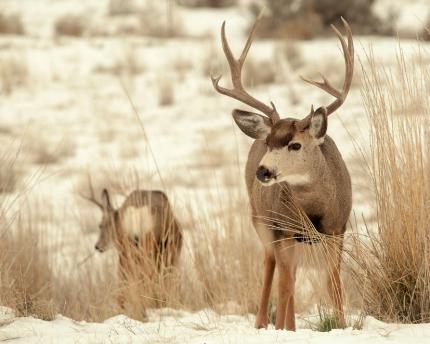
Deer are among the most familiar animals of Washington, and in many places they are the largest wildlife that people encounter. Their aesthetic beauty is appreciated and admired, although their fondness for garden and landscape plants tries some peoples’ patience. Typically, deer feed in open habitats such as meadows and clearcuts, retreating to more secure areas, such as thickets and closed canopy forests, to rest and chew their cud.
Deer are a type of mammal known as an ungulate, meaning they walk on their toes, or "Hooves". One unique characteristic of the deer family is their antlers. While horns remain permanently affixed to the skull, antlers are shed every year. Although deer may be active at any time of day, they are most active near dawn and dusk (a pattern of activity called “crepuscular”).
Facts about Washington deer
Food and feeding habits
- Deer eat a wide variety of plants, but their main food item is browse—the growing tips of trees and shrubs. In late winter and early spring, deer eat grass, clover, and other herbaceous plants.
- Deer also eat fruit, nuts, acorns, fungi, lichens, and farm and garden crops if available.
- For their first few weeks of life, fawns thrive on milk, which is more than twice as rich in total solids as the best cow milk.
- Deer eat rapidly and, being ruminants, initially chew their food only enough to swallow it. This food is stored in a stomach called the “rumen.” From there it is regurgitated, then re-chewed before being swallowed again, entering a second stomach where digestion begins. From there it is passed into a third and then a fourth stomach, finally entering the intestine.
Shelter and range needs
- Deer are sometimes referred to as “edge” species, meaning they thrive at the interface of openings and cover patches. This allows deer to feed in productive openings while being close to escape cover.
- Many wooded suburban environments, such as parks, greenbelts, golf courses, and roadsides, meet the needs of deer.
- Mule deer can move long distances during spring and fall migrations to avoid mountain snow. Mule deer summering in the Cascades migrate as far as 80 miles to reach adequate winter range.
- Black-tailed and white-tailed deer normally reside within a ½ to 3 square-mile area; in mountainous locations, they move to lower elevations for the winter.
Reproduction and family structure
- Deer breed during a rutting season that normally occurs in November and December. Bucks compete for the right to breed using ritualized posturing and movements, and occasionally through intense fighting.
- Unlike elk, deer bucks do not herd groups of females; however, a single mature buck may breed with several females.
- Pregnancy lasts 180 to 200 days. Younger does give birth to one fawn, while does three to nine years of age and in good condition often have twins. White-tailed deer will occasionally have triplets.
- Newborn fawns nurse soon after birth and can walk on spindly legs almost immediately.
- Adult bucks take no part in raising fawns, and generally remain solitary or form bachelor groups throughout the summer.
- Family groups usually consist of a doe and her fawns, and sometimes her fawns from the previous year. Occasionally, groups of several does may be seen together.
- In winter, deer may be observed in larger groups of 15 to 30, usually grouping because they are concentrated in limited winter habitat.
Mortality and longevity
- Cougars, bears, coyotes, and domestic dogs prey on adult deer; young fawns fall victim to these species as well as to eagles and bobcats.
- Hunting, vehicles, and diseases all take their toll on deer. In many deer populations, hunting dampens the effects of other mortality factors; as hunting mortality decreases, other forms of mortality tend to increase, and vice versa.
- Few deer live longer than ten years, and most live for no more than five.
All about antlers
Male fawns develop buttons (small bumps on top of the head) at six to eight months of age. These buttons are the rudimentary beginnings of the young buck’s first antler set (Fig. 2). Just before the fawn’s first birthday, these velvet-covered buttons begin to elongate, growing from bony extensions of the skull known as pedicels. By September these first antlers are fully grown spikes, or small, forked antlers with two points.
Each year, the antlers tend to grow in mass and diameter. Older bucks tend to have more antler points than younger bucks, but the number of points is not a reliable indicator of actual age. Antler size and conformation also respond to nutrition, and thus serve to advertise the physical condition of the buck. Rich feeding in captivity has produced five-point antlers on yearlings, while a meager food supply can limit even dominant bucks to forks. Bucks generally attain adult-size antlers when they are four to five years of age, but the size and weight of the antlers may continue to increase each year until age ten.
Antlers serve to establish dominance hierarchies among bucks. Big antlers, like bright feathers on male songbirds, are an example of fitness evolved through sexual selection. Because large antlers mean a buck has either survived many years, has superior genetics, or uses high-quality areas, bucks with large antlers make good sires for a doe’s fawn. Does tend to select dominant bucks with large antlers for their mates, and this selection enhances the success of bucks with large antlers even more.
Bucks carry their antlers through the fall, dropping them between late December and early March. Hormonal changes cause a weakening of the bone at the tip of the pedicel, where the antler-growing center is located, and the pedicel/antler connection eventually becomes so weak that the antler separates and falls from the pedicel.
Most antlers that have been on the ground for more than a few weeks will show considerable signs of gnawing by smaller animals, and after a year most of the antler points will have been considerably shortened by these mineral craving critters. Dropped antlers are chewed by mice, rats, squirrels, hares, and porcupines, helping them to sharpen their front teeth while supplying them with calcium, phosphorus, and other minerals.
Common deer of Washington
Two species and four subspecies of deer occur in the state.
Rocky mountain mule deer (Odocoileus hemionus hemionus) (Fig. 1), or mule deer, inhabit areas east of the Cascades in Washington, preferring open forests and sagebrush meadows. During summer, mule deer are tan to light brown; during winter, they are a salt-and-pepper gray. They have large, dark-edged ears, from whence they derive their name. The 7 to 8 inch tail of a mule deer is white, except for a black tip. Mule deer are the largest deer in Washington. Adult buck (males) weigh up to 250 pounds; adult doe (females) weigh 120 to 170 pounds.
Columbian black-tailed deer (Odocoileus hemionus columbianus) are our most common deer subspecies. They occur from the crest of the Cascades west to the ocean, preferring brushy, logged lands and coniferous forests. Many of the physical characteristics of black-tailed deer are similar to those of the larger mule deer. The tail is broader and the backside of the tail is covered with dark brown hair that grades to black near the tip. When alarmed or fleeing from danger, the tail may be raised, displaying the broad, white underside. Adult black-tailed deer bucks weigh 140 to 200 pounds and adult does weigh 90 to 130 pounds.
White-tailed deer (Odocoileus virginianus) occur in eastern Washington on farmlands, in low-elevation stream and river corridors, and near populated areas. White-tailed deer are usually reddish tan in summer and brownish gray in winter. They derive their name from their broad, 10 to 11 inch long tail. When alarmed, white-tailed deer raise their flaglike tail, displaying the white underside. White-tailed bucks weigh 150 to 200 pounds and adult does tip the scales at 110 to 140 pounds.
Columbian white-tailed deer (Odocoileus virginianus leucurus) are found in limited areas along the lower Columbia River. Once common in other areas, this species was federally listed as an Endangered species in Washington and Oregon in 1967.
Hybrids of mule deer/black-tailed deer and mule deer/white-tailed subspecies are known to occur. Mule deer/black-tailed deer hybrids are common where their ranges overlap. Mule deer/white-tailed deer hybrids are not common, but are occasionally seen where both species occur in close proximity.
Viewing deer
Deer often become very habitual in their activities. They show up at the same time and follow the same trails, taking paths of least resistance. To observe deer, position yourself at dawn or dusk near cover in a good deer-feeding area. Remain absolutely still, because deer are alert for any movement. They also have a good sense of smell; stay downwind of the feeding area to prevent deer from detecting your scent. Deer in wild hunted areas will probably not stay around long if they notice you; deer in areas where hunting is not permitted are more likely to tolerate your presence.
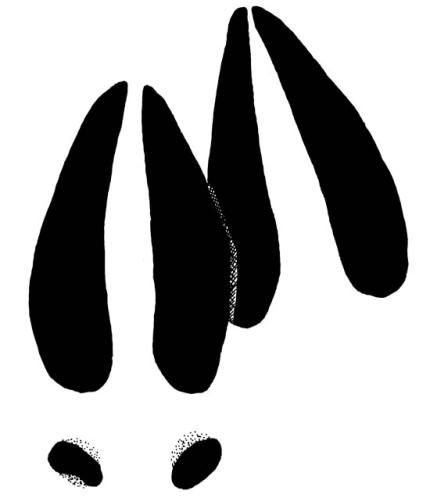
Conditions in the fall can make for good deer viewing. Bucks are battling each other for females and are not as concerned about staying hidden. Leafless trees afford you greater visibility, and when it is raining there is less chance of you being heard crunching through an area. However, be aware of open hunting seasons during this time of year and wear bright orange clothing for your safety.
Winter can be a good time to view deer because they are often concentrated at lower elevations. This is a critical time for deer and, if harassed, deer will expend vital energy to flee the harassment. However, during winter deer can often be observed without harassment by using binoculars and spotting scopes to scan open, sunny areas, especially those with significant shrub cover.
Finally, never approach a deer closely; if threatened it can cause serious injury. Doe deer especially will go to great lengths to defend their young.
Tracks and trails
Deer tracks are easy to identify (Fig. 3). In a normal hoof print, the two roughly teardrop-shaped halves print side by side to form a split heart. When a deer is walking on a slippery surface, such as mud or snow, its hooves are likely to be spread into a V, which helps keep the deer from sliding forward. Deer have regular routes through their home range; these become well-worn trails that look a little like narrow human footpaths. The trails are clear of low vegetation, but are not bare unless they are in shade or are heavily used by deer and other mammals.
Feeding areas
In areas where many deer live, a noticeable “browse line” appears on trees where the deer have repeatedly reached up to eat low-hanging twigs and branches. Similarly, the tops of shrubs may be browsed, leaving only a few inside branches extending upward. Browsing seldom occurs more than 4 feet above the ground, except in areas with deep snow.
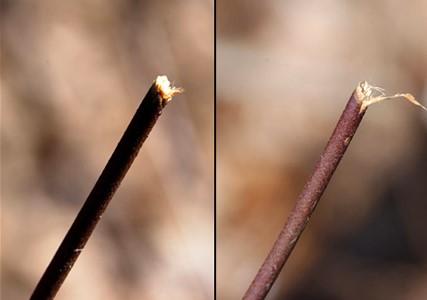
Browsing by deer can usually be identified since twig ends deer have browsed have a ragged appearance, while those browsed by rabbits, porcupines, and other rodents have a neat, clipped appearance (Fig. 4). This is because deer lack upper incisors and canine teeth, and cannot nip off twigs (Fig. 5). Instead they must press foods between their hard upper palates and their bottom teeth, and jerk their heads up to tear it free.
However, when deer browse new growth they leave a clean, blunt stem-end, where the tender shoots break off. The height of the clipped plant will then be the indicator of what species ate it. When browse and other green foods are no longer available, deer strip bark from young trees.
Rubbing sites
Bucks scrape off the velvet covering their antlers by rubbing them against young trees and shrubs. These rubbing sites also communicate their presence and breeding readiness to other deer. This communication has several facets: the visual sign left by the buck’s rubbing, chemical signals left from glands on the buck’s face, and the sound of the buck thrashing branches of the tree on which it is rubbing.
Bedding areas
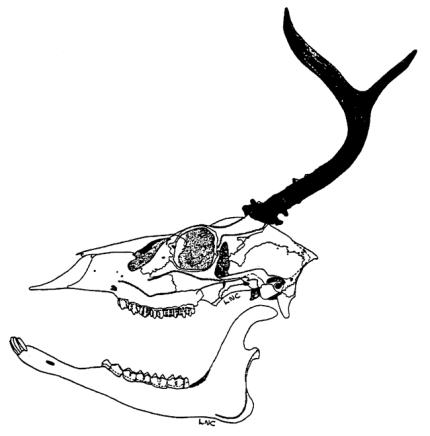
An area of flattened vegetation 3 to 4 feet long and 2 to 3 feet wide indicates where a deer has bedded down. Deer sleep in dense cover or tall grasses and may return to the same spot over many days. Since deer often travel in small groups, there may be several “deer beds” in the same vicinity. During winter, similarly sized depressions in the snow, often littered with old hairs, characterize bed-sites.
Calls
The best-known vocalization is an alarm whistle, “snort,” or “blow,” made when deer exhale forcefully through their nostrils. The sound resembles a sudden release of high-pressure air. The snort is a danger call that alerts all deer in the area of a potential predator.
Older fawns commonly bleat when frightened, and older deer sometimes do as well. Doe deer call to their hidden fawns with a soft, gentle mewing sound, and fawns respond quickly to this call by seeking the side of their mother. Bucks make a grunt during the rut.
Deer fawns and what to do if you find one
To reduce the risks of a predator locating her fawn, a doe seeks seclusion just prior to birth, trying to be less conspicuous by avoiding other deer. For the first few weeks of the fawn’s life, the doe keeps the fawn hidden except for suckling bouts. The doe may also feed and bed a considerable distance from the fawn’s bed site. This way, even if a predator detects the doe, the fawn may still have a chance of avoiding detection.
To further keep her fawn safe from predators, the doe consumes the fawn’s urine and droppings to help keep the fawn as scent-free as possible. The droppings provide the mother with further nutrition at a time when it is much needed.
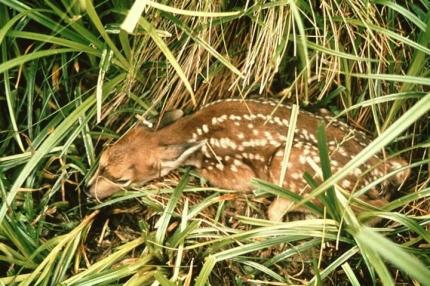
When not nursing, the fawn curls up in a bed site and remains motionless, its white spots blending in well with the sun-flecked ground (Fig. 6). Fawns lose their spots at 90 to 120 days of age, when they begin growing their winter coats.
Every year, wildlife departments and wildlife rehabilitators receive calls about “orphaned” fawns. Callers are told that in the spring it is a perfectly natural occurrence to come across a fawn that is seemingly by itself in the woods. The fawn is probably not alone; its mother is nearby, aware, and attentive.
The advice to anyone encountering a fawn lying quietly alone in the woods is to leave it alone. Mother will be nearby and will be taking care of it once you move away.
If you have handled the fawn, rub an old towel in the grass and wipe the fawn to remove human scent. Using gloves, return the fawn to where it was found. Fawns can often be returned to their mothers if taken back to where they were found within eight hours.
If a fawn appears cold, weak, thin, or injured, and its mother does not return in approximately eight hours, it may be orphaned. In such a case, you can call a local rehabilitator (look under “Animal” or “Wildlife” in your phone directory) or your local WDFW Regional Office for the name and phone number of a rehabilitator in your area. (For additional information, see wildlife rehabilitation in Washington.)
Tips for Attracting Deer
Although property owners with large acreage can provide significant deer habitat, those with small acreage can also contribute. Keep in mind that deer may damage ornamental plants and gardens, and might also attract animals that prey on deer, such as cougar and bear
The best way to attract deer to your property is to protect and maintain deer habitat:
- Provide hiding cover. Deer use hiding cover year-round during resting periods throughout the day, but it is especially important during hunting season and the first few months of a fawn’s life. Hiding cover can consist of stands of trees or dense shrubs. Where cover is limited, providing large, disturbance-free areas may still encourage use by deer.
- Conserve areas with forage plants that deer prefer (Table 1 (PDF)).
- Prevent infestations of noxious weeds that degrade areas containing preferred food plants (contact your county extension office for information).
- Conserve vegetation along streams and other freshwater areas and avoid placing roads near these areas, which are among the most favored habitats of deer. Consider developing artificial watering areas if water is scarce on your property.
- If a contractor is clearing vegetation, make sure the contract states that the contractor will be held responsible for plant restoration or alternate improvements if areas set aside for deer are inadvertently cleared. Temporarily fence important areas and supervise the work to keep disturbances to a minimum.
- Consult with local resource management agencies for advice on specific habitat-management activities that may be highly effective in your local area. These activities might include prescribed burning to rejuvenate shrub species, fertilizing of old fields to increase palatability of forage to deer, and not mowing areas that provide food and shelter.
- Do not let dogs run loose and chase deer. This fatigues and weakens deer, especially when they are forced to run on crusted snow. Deer can also be killed by dogs, either directly or indirectly, because fleeing burns up energy needed to combat cold and starvation. Dogs running in packs are even more threatening to deer. Some county laws provide for shooting dogs and/or fining their owners if dogs are observed harassing wildlife.
- Inform guests, visitors, and contractors coming to your property that you do not allow dogs to roam free.
- Property fences and wire fences constructed on ranges used by deer should have a 17-inch gap at the bottom to let fawns and adult deer pass beneath them, and be no more than 4 feet high to let adults jump safely over them.
Preventing Conflicts
In most places deer are valued as watchable wildlife or as game animals. However, where hunting is limited or no longer permitted and natural predators are few, deer populations can increase to a point where human/deer conflicts become a concern.
Problems associated with high deer populations include damage to crops, ornamental plants, restoration and reforestation projects, and deer/vehicle collisions.
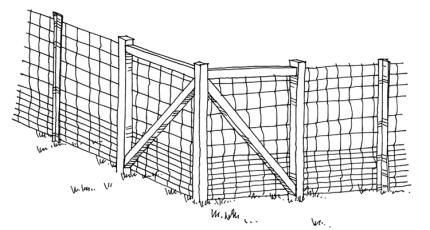
Problem areas are often where new development has appeared in traditional deer habitat. Those who live on the edges of new developments, or adjacent to undeveloped areas, may experience higher deer damage than others whose homes are within developments or otherwise buffered by urbanization. However, deer readily adapt to human activity and are seen in unlikely places at times.
If deer damage is occurring on commercial property, a wildlife agent from your local wildlife department can assist you in evaluating damage-control options. Your local wildlife office may also have cost-share or other programs available to help you manage deer on your property.
Deer Fences
When deer browsing is moderate to severe, or a landowner isn’t willing to tolerate even a limited amount of damage, fencing to exclude deer is the only option (Fig. 7, 8). However, traditional deer fences are not always practical because of appearance, zoning restrictions, cost, or rugged terrain. In such cases, another type of barrier described below may be appropriate.
Before installing a deer fence, ask these questions:
- Must my entire property be protected or only certain parts, or certain plants?
- Is this need temporary, such as to protect young trees for a few years?
- Are there visual constraints, including aesthetics, or your neighbor’s or a passerby’s view?
- Are there any community or local government regulations or restrictions?
- Is building a fence time- and cost-effective, or should other methods be considered, even though they are not as effective?
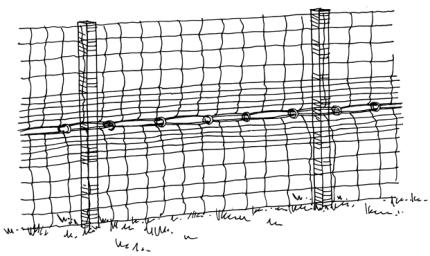
Before you build: If you decide to build or have a fence built, construct it properly. A poorly constructed deer fence is dangerous to the deer, and will not protect your valuable plants. If a deer fence exists nearby, ask the property owner about its effectiveness, its construction, and who built it. To locate a fence builder, look under “Fence Contractors” in your phone directory. Request references and follow up on them before hiring any contractor.
If you build a deer fence yourself, carefully measure the area to insure the efficient use of fence rolls. (You don’t want to end up having to cut a small length of fence from a new and potentially expensive roll). In addition, make sure you know where your property line is—existing fences may not be on your property. Never fence across an easement without notifying the necessary authority.
Fencing facts:
- It is easier to build a fence while the land is vacant; when possible, fence an area before you plant an orchard or a garden.
- Enclose the entire area needing protection (including driveways). Deer will wander the perimeter of the fenced area until they find an opening.
- Keep fencing material flush to the ground (including under gates). Fill dips with gravel, rocks, logs, or other suitable material. Incredibly, deer will try to either crawl under or squeeze through a fence before jumping over it.
- Deer can be excluded from areas with a properly constructed and maintained 6 to 8-foot high fence. The higher fence will be needed in an area with many deer and a low supply of wild food.
- A board fence or hedge that prevents deer from seeing a safe landing zone on the other side need be only 5 1/2 feet high.
- The larger the area being enclosed, the more travel patterns will be disrupted, and the more pressure the fence will receive.
- Large areas with high deer pressure should be fenced with woven-wire deer fencing or a high-tensile electric wire. Heavy-duty black polypropylene deer fencing is commercially available and useful where other fencing is visually obtrusive.
- Information on corner bracing, stretching wire, and other fence-building details can be obtained from fencing material suppliers.
Electric fences: A properly designed and maintained electric fence can be very effective at preventing deer from entering an enclosed area as small as a vegetable garden or an area as large as a commercial orchard. One or two hot wires can also be strategically placed to keep other animals out of chicken coops, ponds, and other areas (Fig. 9).
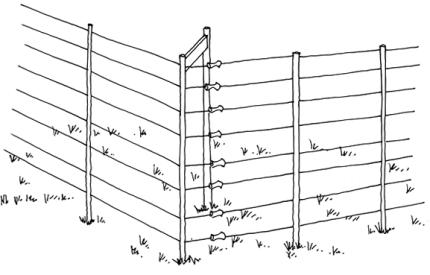
Electric fences work by delivering a high-voltage but low amperage jolt that won’t set fire to plants or injure animals or humans. Some fences are built with alternating positive and negative wires so an animal receives a shock when it touches both wires simultaneously. More commonly, the animal completes the circuit when it touches a hot wire while standing on the ground. The advantage of this design is that the animal only has to touch one wire to receive a shock. One disadvantage is that plants must be kept from contacting the wire or the fence will short circuit. (Newer low-impedance chargers make this less of a problem.)
A fence with eight wires evenly spaced to 80 inches is believed to be adequate to keep deer out of an enclosed area. Due to the variables affecting your selection of a power source, and fence design and operation, it is best to consult a reputable dealer for the specifics regarding its use (look under “Fence Contractors” in your phone directory). Information is also available from farm supply centers. Most home improvement centers carry units suitable for protecting gardens. Consult your local zoning office and neighborhood covenants to determine if electric fences are permitted where you live.
Here is some general information on electric fences:
- An electric fence is not a physical barrier to entry. It acts as a psychological barrier that some deer will continually test. Because of this, it is important that your fence be properly designed, installed, powered, and maintained.
- Maintenance visits are required at least every two weeks to check the voltage and to rectify any problems, such as fixing sagging wires. However, inspections every two days will be necessary during the first three weeks after installation. This is to make certain that animals encountering the fence for the first time don’t damage the fence or get injured.
- An electric fence can be less expensive to build than woven wire fences, but requires more effort to maintain and will not last as long.
- Recently available electric polywire/tape fencing is much wider and is meant to also work as a visual repellent. It is less expensive, relatively portable, and easy to install. Also, it can easily be removed for mowing or farming and moved to other locations as the need arises.
- Poor conductivity occurs in rocky or dry ground. Most projects fail because of poor grounding.
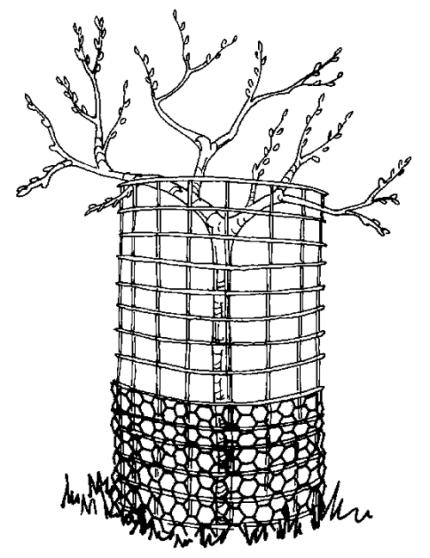
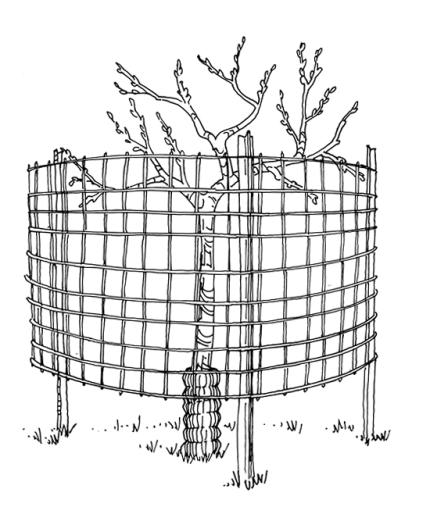
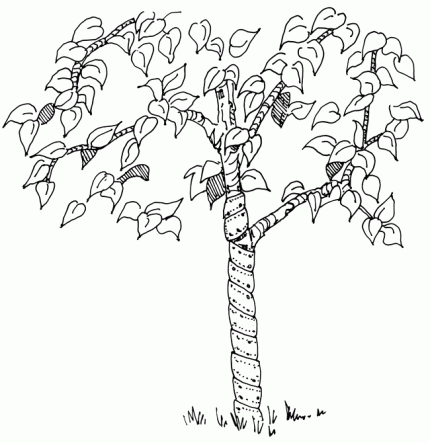
Mini-Barriers
Barriers to protect small areas, individual plants, or vulnerable parts of plants can be purchased or made at home (Fig. 10). These have the advantage of being less expensive and obtrusive than full fences, allowing deer access to surrounding food plants while protecting others. They can also protect plants from bucks rubbing their antlers, which breaks branches and strips bark off trunks.
To prevent deer from pushing over or moving a mini fence surrounding a tree or shrub, the fence should be 5 feet high and staked to the ground.
Netting—normally sold to protect berries and fruit from birds—can be draped over individual plants or used as a temporary fence. However, deer can easily break lightweight netting with their hooves to get to desirable plants and songbirds can get entangled in excess netting. Stronger netting material is commercially available from bird-control outlets and companies selling polypropylene deer fencing. When draped over plants, any netting will need continual rearranging to protect new growth.
An inexpensive and subtle deer barrier can be made from 100-pound test monofilament fishing line tied to sturdy, 5-foot tall stakes, or attached to a structure. At a 12-inch spacing, fishing line works best to protect small enclosures, such as surrounding several rose bushes.
Commercially available tree guards protect trees from damage done to the bark from deer antlers and gnawing from other wildlife (Fig. 11). They can be wrapped around nearly any size tree, cut to different heights, and expand as the tree grows.
Plastic or nylon tubes, netting, and bud caps have all been used successfully to protect small transplants and growing tree tips (Fig. 12). For small plants, use tubes that match the plant’s height and allow room for growth. Be sure to hold the tube upright with a wood or metal stake.
Cattle guards
Some people see cattle guards as eyesores, but they provide the most effective protection for ungated driveways on properties that are otherwise fenced to keep deer out.
Before installing a cattle guard, it’s important to determine how many deer use the driveway (assuming a deer fence encloses the perimeter of your property). In areas where deer concentrations are heavy, deer will test the cattle guard and are known to jump over one that is undersized.
Most cattle guards are about 7 feet wide and 10 to 14 feet long. You will need a backhoe to excavate a hole and to lower the sections into place; each section weighs over 1,000 pounds.
Repellents
Deer repellents use a disagreeable odor or taste, or a combination of both, to dissuade deer from eating the treated plant. They are easy to apply and homemade solutions are inexpensive.
Numerous odor and taste repellents have been developed to reduce deer damage, and new products are continually becoming available. There have been numerous studies to test the effectiveness of these repellents, often producing conflicting results. No repellent eliminates deer damage entirely.
An All-in-One Homemade Deer Repellent
Mix the following in a 1-gallon tank sprayer:
- 2 beaten and strained eggs— strain them to remove the white strings surrounding the yolk, which otherwise will plug up your sprayer).
- 1 cup milk, yogurt, buttermilk, or sour milk
- 2 tsp. Tabasco sauce or cayenne pepper
- 20 drops essential oil of clove, cinnamon, or eucalyptus, found in small bottles at health food stores
- 1 tsp. cooking oil or dormant oil
- 1 tsp. liquid dish soap
- Top off the tank with water and pump it up. Shake the sprayer occasionally and mist onto dry foliage. One application will last for 2 to 4 weeks in dry weather.
Before you apply: Most repellents function by reducing the palatability of the treated plant to a level below other available plants. Hence, repellent effectiveness depends upon the availability of wild deer food. Repellents are more appropriate for short-term rather than long-term problems and are the most practical for non commercial users experiencing low to moderate deer damage.
Repellents work best if applied before the deer develop a routine feeding pattern. This means applying repellents before leaves or flower buds emerge and as new growth appears. It’s easier and more effective to prevent a feeding habit from forming than to try to break an established one.
Repellent facts:
- Spray-on repellents need to be applied frequently to protect the new plant growth, and will need to be reapplied after rain and long exposure to hot, dry, or windy weather.
- Deer may become accustomed to the same repellent over time, and eventually ignore it. Alternating repellents may help keep deer confused and more wary of eating your plants.
- Repellents that are applied to plant surfaces are generally more effective than capsules containing garlic oil, bags of hair, or other devices that produce an odor intended to protect a specific area.
- Finally, before putting complete faith in a repellent, first try it on a small area. Always use commercial repellents according to the manufacturer’s directions.
Scare tactics
Like most animals, deer are neophobic (fearful of novel objects), and many scare tactics take advantage of this behavior. However, deer soon get accustomed to new things and damage resumes after they realize no actual harm will come to them. As with repellents, a given tactic will work on some deer, but no single one seems to work on all of them. If the animals are already use to feeding in the area, scare tactics will last an even shorter length of time.
Scare tactics can be visual (scarecrows, bright lights, spare blankets), auditory (noisemaking devices such as exploders, whistles, etc.), or olfactory (predator urine or droppings).
One recent innovation is a motion sensor combined with a sprinkler that attaches to a hose. When a deer comes into its adjustable, motion-detecting range, a sharp burst of water is sprayed at the animal. This device appears to be effective by combining a physical sensation with a startling stimulus. Similar in approach but less effective are radios and lights hooked up to a motion detector.
A dog can help keep deer away, especially if it is large and awake. To keep the dog at home while simultaneously repelling deer from your property, use a “dog trolley” or an invisible (buried electric) fence, where practical. Avoid tethering a dog near stairways and fences, and provide at least 15 feet of cleared space for it to move around in. Do not use a choke chain, and remove all debris that could tangle or injure your dog. Provide shade, water, and shelter for the dog at all times.
Landscaping with deer-resistant plants
Although a deer fence or other barrier is the best insurance against damage, landscaping with deer-resistant plants is a more aesthetic alternative. In addition, there may be areas where a deer fence isn’t practical. A walk or drive through the neighborhood or a visit to the neighbors can give you an idea of what plants are less palatable to deer.
Whether or not a particular plant will be eaten depends upon several factors: the deer’s nutritional needs, its previous feeding experience, plant palatability, time of year, and availability of wild foods. When preferred foods are scarce, there are few plants that deer will not eat. A large deer population can create competition for food, causing deer to eat many plants that they normally would avoid.
Deer develop predictable travel patterns, and prior damage is often a good indicator of potential future problems. Any new plantings added to an existing landscape or garden already suffering from severe deer damage will likely also be browsed.
The list of deer-resistant (or close to it) plants is a general guide. Deer sometimes will browse the plants listed and sometimes will avoid plants not listed. Note: A few vigorous native plant species are included in both Tables 1 and 2 (PDF).
Tips for driving in deer country
Vehicles kill hundreds of deer each year in Washington. Deer will cross roads at any time of the day or night, creating a hazard for the vehicles, passengers, and deer.
More than half of all deer/vehicle collisions occur in October and November. The rut (mating season) and peak days for hunting may account for this.
Here are driving tips to help prevent collisions:
- Deer are most active at dawn and dusk. Be especially watchful during these times.
- One deer crossing the road may be a sign that more deer are about to cross. Watch for other deer-- they will move fast to catch up with leaders, mothers, or mates and may not pay attention to traffic.
- When you see brake lights, it could be because the driver ahead of you has spotted a deer. Stay alert as you drive by the spot, as more deer could try to cross.
- Wonder why the person ahead is driving so slowly? The driver may know where to slow down and be extra alert for deer. Don’t be too quick to pass, and watch out.
- Take note of deer-crossing signs and drive accordingly. They were put there for a reason.
- Try to drive more slowly at night, giving yourself time to see a deer with your headlights. Lowering the brightness of your dashboard lights slightly will make it easier to see deer.
- Be especially watchful when traveling near steep roadside banks. Deer will pop onto the roadway with little or no warning.
- Be aware that headlights confuse deer and may cause them to move erratically or stop. Young animals in particular do not recognize that vehicles are a threat.
- Deer hooves slip on pavement and a deer may fall in front of your vehicle just when you think it is jumping away.
- Deer whistles, small devices that can be mounted on your vehicle, emit a shrill sound that supposedly alerts deer nearby. (Humans cannot hear the sound.) How well the devices work is not scientifically known.
Public health concerns
Deer are not considered a significant source of infectious diseases that can be transmitted to humans or domestic animals. However, as you would when dealing with any wild animal, it is recommended that you wear rubber gloves if you need to handle a sick or dead deer, and wash your hands afterwards. Fully cook all deer meat to 160°F.
Anyone who believes they may have contracted any disease from a deer should consult a physician as soon as possible, explaining to the doctor the possible sources of infection.
Legal status
Because legal status, hunting restrictions, and other information about deer change, contact your WDFW Regional Office for updates.
Mule deer, black-tailed deer, and white-tailed deer are classified as game animals (WAC 220-400-020). A hunting license and open season are required to hunt them.
After obtaining a permit issued by the Department of Fish and Wildlife (WDFW), a property owner or the owner’s immediate family, employee, or tenant may kill a deer on that property if it is damaging crops (RCW 77.36.030). You must notify WDFW immediately after taking a deer in these situations.
The Columbian white-tailed deer is classified as a state and federal Endangered animal and may not be hunted or killed (WAC 220-610-010).
Additional Information
Feeding deer in urban and suburban areas... is it harmful? (PDF)
Books
Conover, Michael. Resolving Human—Wildlife Conflicts: The Science of Wildlife Damage Management. Boca Raton, FL: Lewis Publishers, 2002.
Hygnstrom, Scott E., et al. Prevention and Control of Wildlife Damage. Lincoln, NE: University of Nebraska-Lincoln, Institute of Agriculture and Natural Resources, 1994. (Available from: University of Nebraska Cooperative Extension, 202 Natural Resources Hall, Lincoln, NE 68583-0819; phone: 402-472-2188; also see Internet Sites below.)
Juhre, Robert G. Preventing Deer Damage. 3rd edition. Kettle Falls, WA, 1998. (Available from: Robert G. Juhre, 1723 Mountain Garden Way, Kettle Falls, WA 99141-9771.)
Link, Russell. Landscaping for Wildlife in the Pacific Northwest. Seattle: University of Washington Press and the Washington Department of Fish and Wildlife, 1999.
Maser, Chris. Mammals of the Pacific Northwest: From the Coast to the High Cascades. Corvalis: Oregon State University Press, 1998.
Shackleton, David. Royal British Columbia Museum Handbook: Hoofed Mammals of British Columbia. Vancouver, BC: University of British Columbia Press, 1999.
Verts, B. J., and Leslie N. Carraway. Land Mammals of Oregon. Los Angeles: University of California Press, 1998.
